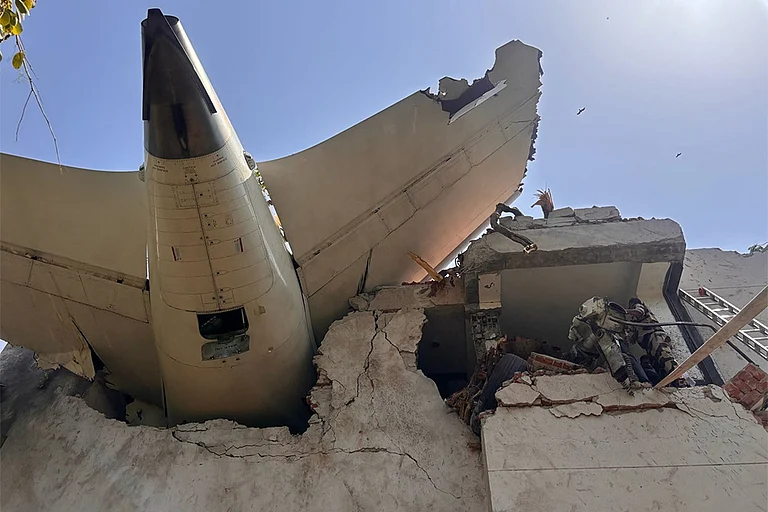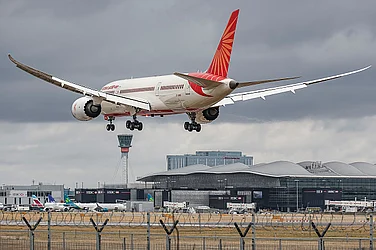The subtext of the most heartrending story from the Air India crash at Ahmedabad—the grimly ironic happy selfie posted by Prateek Joshi’s wife Kaumi of the couple and their three adorable children just before take off—has somehow been overlooked in the terrifying aftermath of the tragedy. They were flying economy class. Joshi, a medical practitioner in London, was taking his family to start a new life overseas. The cheaper, cramped coach class played the backdrop to the aspirations of the family.
Economy class, in a way, symbolises the resurgent Indian middle-class ambition to go out, meet the world, settle down, and send home a share of their success as remittances. An RBI survey in March this year came as confirmation of the reassuring fact that for India, the size of the money order from developed countries has grown impressively big.
The factor impacting the good story is the surge in the flow of educated and technically skilled manpower to developed countries, with a strong preference for the US, the UK, Canada, Singapore and Australia. Even students going abroad for higher education tend to stay back, seizing work opportunities. India, according to a World Bank report, has moved to the top of remittance recipients in the world, with annual receipts crossing $100 billion in 2022.
The reason the ripples have turned into a tide is partly demographic. About 150,000 Indians legally migrate to America every year. The number will be more if undocumented migrants are taken into account. People of Indian origin in Canada number close to two million. And about 27 per cent of Canada’s international students are Indian.
The sizable diasporic economy has actually helped India tide over the huge trade deficit that, not so long ago, got perilously close to a crisis point. The RBI admits as much. “India's remittances have more than doubled from $55.6 billion in 2010-11 to $118.7 billion in 2023-24. While financing around half of India’s merchandise trade deficit, net remittance receipts have been an important absorber of external shock.”
On their first long flight overseas, most aspirants must have flown economy class. The perceived indifference of the cabin crew in the case of a leading international airliner or the tiring long line and grilling at immigration at the destination—the travel experience might be the first of many shocks, enough to make them feel unwelcome.
The truth, however, is that many of the economy-class passengers would be running essential services like hospitals as qualified, efficient doctors and form part of some crucial sectors of the economy, apart from having a significant presence in academia in their adopted countries.
The picture could take on a much gloomier shade at times. At the big Indian airports, you might have come across this surreal scene: a group of overawed, inadequately dressed men, herded together by an agent, waiting tentatively for some final instructions before getting inside with trepidation for the first flight of their life. They are part of the Gulf-bound workforce—plumbers, carpenters, masons, electricians, drivers—all bona fide passengers with valid tickets, but often treated shabbily by flight attendants. Contrast their humiliation with the exciting money orders they send home. About 9 million Indian workers in the UAE, Saudi Arabia, Kuwait, Qatar, Oman and Bahrain, constituting almost 30 per cent of the entire expat workforce in those places, account for 38 per cent of India’s total foreign remittances. From the opaque perspective of the cabin crew, economy class might have acquired a class character on international flights. Cattle class?
The reason is not difficult to see. Though the share of business travellers is only 12 per cent of airline passengers, they opt for much costlier tickets and give the airlines more revenue by frequent last-minute bookings. They therefore contribute double an economy passenger’s share, accounting for as much as 75 per cent of profits.
This insensitivity towards working-class passengers from India is in sharp contrast to the fact that an estimated 10 per cent of CEOs of Fortune 500 companies are of Indian origin. About one-third of the techies running the Silicon Valley empire have their roots in India. Most of them presumably opted for economy class on their first flight out. Now, if you are headed for North America with a stopover in Europe, the quality of service significantly improves on the transatlantic second leg of the flight with the partial whitening of the clientele.
Well, the stereotypical bias has an anachronistic air about it when compared with the fact that 163 Indian companies have invested $40 billion in the US, creating 425,000 jobs, according to a CII survey. The largest share of the investments has gone to Texas, Georgia, New Jersey and New York. The CII survey also points out that 85 per cent of these companies plan further investments and 83 per cent intend to hire more employees in the US in the coming years.
The civil aviation sector in India, one of the fastest growing in the world, with a total air passenger traffic of 220 million taking 2014 as the basis, according to available data for 2024, has seen a 4.5 per cent rise in international travel recently. For any global player in civil aviation, that should be enticing enough to focus on this market.
The global market size of the aviation industry in 2023 was $762.8 billion. With the air passenger number projected to surpass 40 billion globally by 2050, the movement for work, education and leisure—both domestic and international—will surely rise further over time. Economy class indisputably is going to be the metaphor for this steady migration trail.
Keeping the massive growth in perspective, even minor gestures of inequality on the part of airliners can actually unleash microaggression on passengers from certain regions.
Legal expert Catherine Mitri brings out a disquieting instance of a leading European airliner subjecting passengers with Semitic-sounding names to humiliating interrogation even after the routine security check, on suspicion of carrying explosives. Of them, ten were made to strip and allowed to fly. The remaining two refused. In her explosive article in the Seattle Journal for Social Justice, Mitri blames the Montreal Convention’s silence on these issues for letting airlines ‘evade liability for misconduct, such as racial discrimination’.
The civil aviation industry is currently experiencing a boom, with an estimated five billion people flying around the world annually. Despite such phenomenal growth, biases have persisted on certain routes. Safety is absolutely non-negotiable but sensitivity in passenger handling brooks no lapse. Even an inadvertent mistake might leave a long-lasting scar. Given the direction the world is moving in, flying economy class is the new emblem of the migrant’s audacious journey to reimagine cultures.
(Views expressed are personal)
(Manimala Roy is an economist who works in the areas of gender and migration. She is the author of From Shanties to School)

























